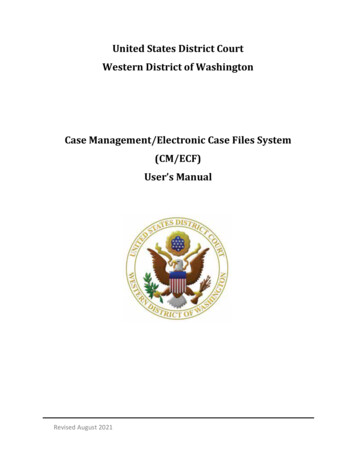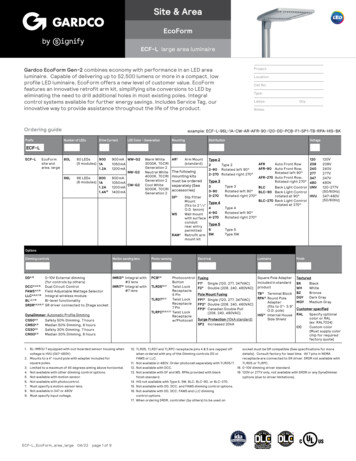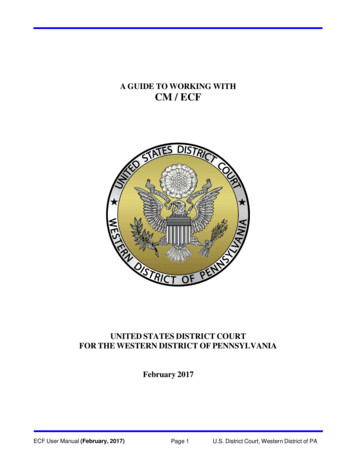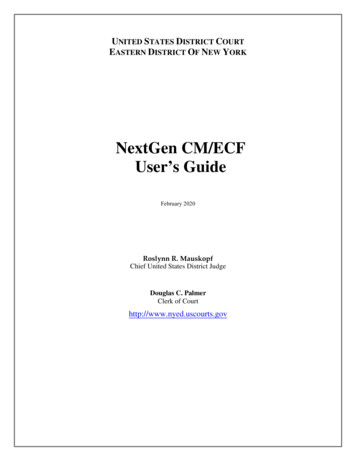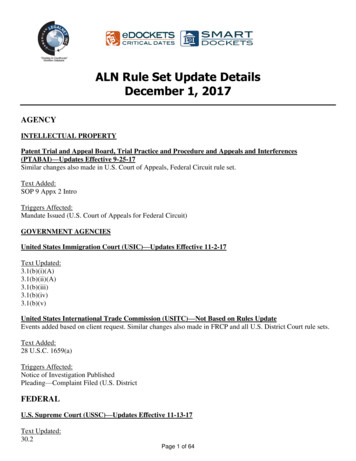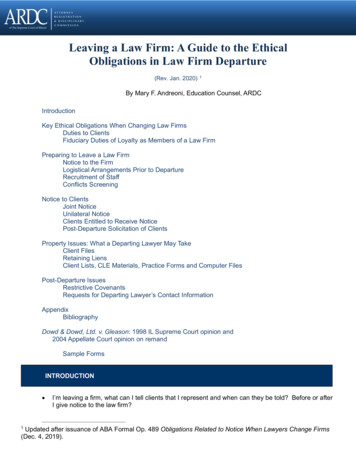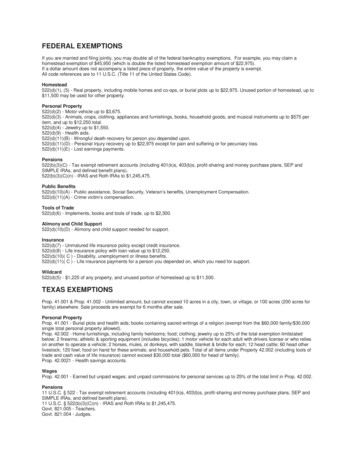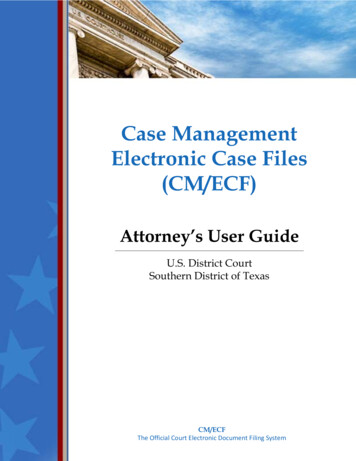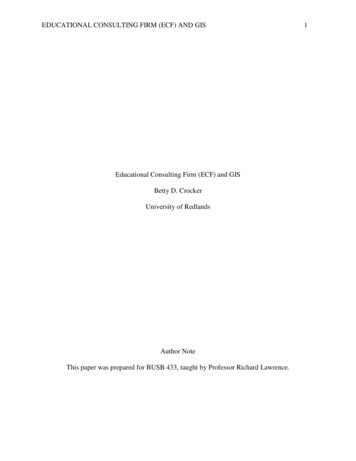
Transcription
EDUCATIONAL CONSULTING FIRM (ECF) AND GISEducational Consulting Firm (ECF) and GISBetty D. CrockerUniversity of RedlandsAuthor NoteThis paper was prepared for BUSB 433, taught by Professor Richard Lawrence.1
EDUCATIONAL CONSULTING FIRM (ECF) AND GIS2AbstractEducational Consulting Firm (ECF) is committed to providing services to international agents ineffective student placement. ECF will utilize GIS to facilitate a resource specific to globaleducation needs, going well beyond a traditional style of consulting. Currently, agents move fromone website/directory to another seeking to identify the most qualified educational institutionmatching the client’s preferences. The product connects all of the various directories and allowsthe agent to query schools based on location, programs, SEVP approval, and accreditation status.The outcome matches the preferences of the student client, ultimately saving time, staffing,research, and money.
EDUCATIONAL CONSULTING FIRM (ECF) AND GIS3In the world of education-related consulting, a wide range of services are available. Manyconsultants focus on the needs of the student or parent in search of schooling options including dayschools, colleges, specialized programs, etc. Other consultants exist to serve the educationalinstitution offering assistance with development of policies and procedures, curriculum andinstruction and services related to school accreditation. In addition to many of the traditionalservices referenced above, Educational Consulting Firm (ECF) is committed to providing servicesto international secondary schools and international agents in the development of enrollment andeffective student placement. ECF, focused on serving students and schools in Southeast Asia, willenlist the assistance of Geographic Information Systems (GIS) to facilitate a resource specific toglobal education needs, going well beyond a traditional style of consulting.International secondary schools seeking to expand enrollment are well advised to utilizeresearch-based information to make key decisions relating to the best marketing approach. Thecosts associated with random marketing could be prohibitive with no guarantee of positive results.International agents face the same issue typically relying on word of mouth to grow their business.Agents also depend heavily on networking through the various international education fairs butagain, the expense involved with travel and rental space does not always prove to be valuable dueto the wide and random approach. For both entities, the ability to utilize specific criteria toidentify potential clients would be a cost effective way to increase enrollment and build revenue.Providing a resource with map segmentations of Southeast Asia identifying potentialclients based on median household income and household size in a similar format available in theUnited States would offer schools and agents the ability to target potential clients in a much lessrandom manner than just being present at an educational expo. However, melding this type ofidentifying information with mapping capabilities via ArcGIS is met with the challenge of limitedor restricted statistical information. Currently, each country’s statistical data is managed separatelyand provided in non-uniform reports. The U.S. Department of Census offers a listing by websitefor each country’s statistical reporting resource (United States Census Bureau, 2012). Forexample, China’s statistical reports are available for purchase from the National Bureau ofStatistics of China in excel or html format which would lend itself nicely to setting up the attributedata necessary for that area (National Bureau of Statistics of China, 2012). Statistical reports arealso available broken down by city as indicated in the Hong Kong Annual Digest of Statistics(Government of the Hong Kong, 2012). Common denominators would need to be established andthen information gleaned from each source based on that criterion. Unfortunately, at this time,creating a database with this information would be cost prohibitive for a small business due to thetremendous amount of research and staffing necessary.Interestingly enough, wide scale mapping at the international level is in developmentthrough a program launched by the United Nations called Second Administrative LevelBoundaries (SALB) (United Nations, 2012). Still in infancy stages and under developmentstrictly on a volunteer basis, the goals of this agency are to provide “access for the collection,management, visualization and sharing of sub national data and information in a seamless wayfrom the national to the global level” (United Nations, 2012). Based on this information, thefuture collection of census related data from country to country may become more standardizedand less expensive to synthesize.
EDUCATIONAL CONSULTING FIRM (ECF) AND GIS4A more viable resource option utilizing GIS, at least with today’s technology, is directedspecifically to agents representing international students. Locating the best suited secondaryschool, whether international or in the United States, can be an arduous task. Operating mainlyby word of mouth referrals, an agent’s reputation hinges on the successful placement of theirstudent client. On an individual basis, agents move from one school website to another obtainingschool profile information. Another critical factor in identifying a qualified educational institutionis checking the school’s accreditation status. Agents travel to each of the six regional accreditationagency websites to search directories of accredited secondary schools. For international schools,accreditation status can be obtained by accessing one of four directories. Further, for internationalstudents desiring to enroll in a secondary school based in the United States, a specialized studentVISA is required. To obtain this VISA, the school offering enrollment must be authorized byHomeland Security to issue the I-20 document and as such, approved through the StudentExchange Visitor’s Program (SEVP) (United States Department of Homeland Security, 2012).International agents search the SEVP directory by school name to confirm SEVP approval or theycan download an alphabetical list hundreds of pages long. Lastly, a final step is needed to visuallysee the locations of the schools as they relate to the student client’s preferences. As it stands now,agents perform this task manually.After interviewing Mr. David Han, International Student Director at Arrowhead ChristianAcademy in Redlands, California, I learned ECF’s product, which would pull all of these stepstogether, has the potential to become a very valuable resource (personal communication,December 2012). Mr. Han communicated that at present, there is no central database to obtain thisinformation (personal communication, December 2012). The product proposed by ECF wouldconnect all of the various directories and allow the agent to query schools based on location,programs offered, SEVP approval, and accreditation status utilizing their student clientpreferences. The outcome would provide international agents with a direct listing of schoolsmatching the preferences of their student client which would ultimately save time, staffing,research and cumulatively, a lot of money.Geographic Information Systems (GIS) require a database of attributes, spatial informationand some way to link the two elements (Pick, 2008). ECF’s product would connect these vitalelements offering a useful and desired resource. The design for this product would beobject-oriented (OODM) and operate within Spatial Web Services architecture. Spatial Webarchitecture will allow for quick exchanges of information between multiple spatial andnon-spatial services. The OODM provides three types of relationships, “aggregation,generalization and particularization” (Bhalla, 1991). At the same time, data operations within anOODM provide a mechanism for “defining schema, creating database, retrieving objects andexpanding objects” (Bhalla, 1991). The product proposed in this project requires all of theseoperations and the menu will allow the user to set specific criteria and extract the informationdesired without any additional work on the part of the database or operator.Within each accreditation agency’s website, a directory of member schools is accessibleincluding name, location, grades served, accreditation status and the school’s website address(Figures 1 and 2).
EDUCATIONAL CONSULTING FIRM (ECF) AND GIS5Figure 1WASC Accrediting Commission for SchoolsSearch for Schools in RedlandsFigure 2WASC Accrediting Commission for SchoolsClicking on Name of School to Access School’s Website AddressAnother resource for agents to locate and identify international schools comes by way ofonline directories offering lists of international schools by regions. Similar to the accreditationagencies, searches within these directories result in location information and access to the school’swebsite (Figure 3).
EDUCATIONAL CONSULTING FIRM (ECF) AND GIS6Figure 3Council of International Schools DirectorySearch of International Schools in South Korea.An additional element of information is necessary to identify U.S. schools acceptinginternational students. The accepting school must be approved by the U.S. Department ofHomeland Security to issue the I-20 authorizing the student to seek an F-1 VISA. SEVP approvedschools are listed within the searchable directory on the Department of Homeland Securitywebsite, accessible to the public and updated on a weekly basis (Figure 4).Figure 4United States Homeland SecurityDirectory, SEVP Approved Schools
EDUCATIONAL CONSULTING FIRM (ECF) AND GIS7The connections of these directories and others related to the process are not only essentialto the product but ultimately become the real cost saving element in the whole structure. Byutilizing the searching capabilities of other databases, ECF is not required to store or maintain allof the various data, thereby reducing expenses associated with data storage. ECF staff wouldbuild a model connecting these searchable databases to mapping options within ESRI’s ArcGIS ora similar structured program. The outcome would offer specified searchable criteria, connected toschool address information which has been geocoded to enable the results to be viewed visually ona map.There are many advantages that come with the presentation of a map offering a visualdisplay of the results of a search. Not only could the international agent visually verify that theschools listed matched the location preferences, by hovering over each point on the map, the agentwould see the school’s name as well as the remaining queried preferences.In the following figures, the attribute data is presented in tabular form and then displayedvisually as points on the map representing schools queried in San Bernardino and Riversidecounties (Figures 5 and 6). In this example, the agent would have entered the following criteria:Preferred AreaAccreditationSEVP ApprovalESL ClassesSports ProgramsMusic ProgramsSouthern CaliforniaSan Bernardino/Riverside CountiesWASCF VISAIndicate Status (Yes or No)Indicate Status (Yes or No)Indicate Status (Yes or No)Based on this information, a school list is generated revealing the name of the school, streetaddress, city, state, zip, accreditation status, F VISA approval and whether or not the school offersESL, sports or music programs.Figure 5Attribute DataSchool usicOntario Christian School931 West Philadelphia StreetOntarioCA91762WASCFNoYesYesWestern Christian School100 West 9th StreetUplandCA91786WASCFYesYesYesArrowhead Christian Academy105 Tennessee StreetRedlandsCA92373WASCFYesYesYesUpland Christian Academy10900 Civic Center DriveRancho CucamongaCA91730WASCFNoYesYesLinfield Christian School31950 Pauba RoadTemeculaCA92592WASCFYesYesYesWoodcrest Christian School18401 Van Buren BlvdRiversideCA92508WASCFNoYesYesLoma Linda Academy10656 Anderson StreetLoma LindaCA92354WASCFNoYesYesThe Webb Schools1175 West BaselineClaremontCA91711WASCFNoYesYesPackinghouse Christian Academy21765 San Bernardino AvenueRedlandsCA92374WASCFNoYesNoCalvary Chapel Christian School24225 Monroe AvenueMurrietaCA92562WASCFNoYesYes
EDUCATIONAL CONSULTING FIRM (ECF) AND GIS8Next, the information included in the tabular structure (Figure 5) is linked by addressidentification and shown spatially on the following map (Figure 6).Figure 6Southern California Map of San Bernardino/Riverside County SchoolsAnother advantage of seeing the results identified on a map is the instant recognition ofnearby locations. The visual display of their locations allows the agent to quickly gleaninformation regarding surrounding areas and potential highlights which would assist in “selling” aSouthern California school location to clients. From the map above (Figure 6), an agent would beable to sell his client on the advantages of choosing a location closer to the beach (LinfieldChristian) or one closer to the mountains (Arrowhead Christian Academy).A factor critical to the international parents sending their children to the United States foreducational purposes is related to the quality and appropriateness of a potential host family. Theideal host family has children of their own around the same age as the international student andalso possesses a similar view as to the importance of a strong education. To this end, taking spatialanalysis a step further, an agent would be prudent to analyze the area surrounding each potentialschool location. By utilizing tapestry segmentation, offered as an additional benefit by ECF,international agents would be able to assure the parents of their international student clients thatthe quality of families within each school’s surrounding area met their desired criteria.Based on ESRI’s Tapestry Segmentation definitions (2012), two of the segmentationgroups most appealing in the selection of potential host families are Segmentation 12, Up andComing Families, and also Segmentation 19, Milk and Cookies. Both are part of the larger FamilyPortrait LifeMode Group and represent younger, more affluent families living in a suburban
EDUCATIONAL CONSULTING FIRM (ECF) AND GIS9environment and having a focus on family (ESRI, 2012). Families within the Family PortraitLifeMode Group have the broadest income scale and therefore, would most likely offer a widerdiversity of living situations and family structures as a result.The following map shows the queried school locations with an overlay of the tapestrysegmentation for Up and Coming Families (Figure 7).Figure 7Up and Coming Families – Segmentation 12Based on this information, the areas of Murrieta, Temecula and Rancho Cucamonga have alarger concentration of the Up and Coming Families.The following map shows the queried school locations with an overlay of the tapestrysegmentation for Milk and Cookies (Figure 8).Figure 8Milk and Cookies – Segmentation 19
EDUCATIONAL CONSULTING FIRM (ECF) AND GIS10The map showing the Milk and Cookies segmentation reveals pockets of families matchingthis criterion within the surrounding area of each potential school location. After reviewing theresults of both of these maps, international student agents would get a better sense of theneighborhoods around each potential school location. Ultimately, their recommendations wouldbe based on more than just looking at a school’s website or viewing the location on a map.The implementation of this product would be accomplished through a variety of methods.In much the same way individual agents would use the product, ECF would use the system fordirect marketing. First, by accessing the international and U.S. school data, targeted marketing tothese schools would get the word out as to the benefit of agents finding their school and matchingit to their student clients. This step would secure potential advertisers for the website as they seekto grow enrollment by gaining the attention of agents using the resource. Connecting withinternational agents would be a bit more difficult but certainly not impossible. The main avenuefor winning over the international student agents would be to market to the associations to whichthese agents belong. For example, ICEF connects educators and education agents to associatednetworks worldwide (ICEF, 2012). Gaining the confidence of associations, ECF will attractinternational agents to this valuable resource.After initial implementation, the benefit of this product will far outweigh the start-up costs.Initially, the tangible costs would be extensive including increased staffing for productdevelopment, data collection, mapping software and associated hardware designed to manage thedata, and other related expenses. However, tangible benefits of this GIS related product would beimmeasurable to those in this field. For international agents, productivity and performance wouldbe significantly improved resulting in more successful student placements and ultimately moreclients.Maintenance of the product would involve the careful planning and monitoring by way ofbeta testing. ECF would implore a handful of agents to participate in the product’s beta testingutilizing their feedback to drive adjustments and also to develop a roadmap for future updates andupgrades.Looking at ECF as a whole, this resource, provided for use by international student agents,would create a continuous stream of revenue by charging agents an access fee and/or by sellingadvertising space on the company’s website. Both options have their advantages anddisadvantages. However, each time an agent is encouraged to access the product, their attention isbeing pulled to ECF’s website and there would be strong potential for additional businessopportunities within the context of educational consulting.To get a better idea of the viability of ECF’s product as a business investment, Porter’sFive Forces Model (Figure 9) provides a categorized view of the potential (Mind Tools, Ltd,2012). Although much of the information necessary for this GIS product is gleaned from othersources, the power of the suppliers is insignificant as their directories are already publicallyaccessible. Further, the only alternative the buyer or international agent has outside of this productis to rely on conducting their business as they have done for years. As such, the threat ofsubstitution is also minimized as they would have to return to the arduous process of searchingindividual databases and compiling their own lists expending enormous resources on time and
EDUCATIONAL CONSULTING FIRM (ECF) AND GIS11staffing. In light of this alternative and also the fact that there is the potential for a larger number ofbuyers or agents as customers, the power of the buyer is also quite insignificant.Figure 9Porter’s Five Forces ModelAlthough there is always a threat of new entry, the start up costs associated with ArcGISand other expenses would offer a strong barrier. As well, there is a specific knowledge needed todiscern where to find the desired information and how to make all of the connections. Reviewingthe four elements above, one could conclude that competitive rivalry might be a consideration forthe future. However, there is a strong unlikelihood of another consulting firm having the abilityand knowledge to provide this resource. Should the resource be offered free of charge with acontractual advertising obligation, the competitive rivalry lessens even more.After examining this product using Porter’s Five Forces Model (Mind Tools, Ltd, 2012),investing in Educational Consulting Firm’s GIS product would garner strong potential withtremendous opportunities for financial gain. The development and implementation of this producthas the potential for extending a powerful resource to this industry with very little risk.References
EDUCATIONAL CONSULTING FIRM (ECF) AND GIS12Bhalla, N. (1991). Object-oriented data models: A perspective and comparative review. Journal ofInformation Science,17(3), 145-160. Retrieved from ntid 14729Council of International Schools. (2012). International Schools Directory [Data file]. Retrievedfrom: http://portal.cois.org/WCM/CIS/Directories/All Schools/CIS/Directory/International Schools.aspx?hkey f164407c-8438-47fe-b813-c95f523ba32bESRI. (2012). Tapestry Segmentation Reference Guide [Brochure]. Retrieved from:moodle.redlands.edu/mod/folder/view.php?id 44039ICEF. (2012). Retrieved from: http://www.icef.comMind Tools, Ltd. (2012). Porter’s Five Forces. Retrieved from: http://www.mindtools.com/pages/article/newTMC 08.htmNational Bureau of Statistics of China. (2012). China Statistical Database. Retrieved , J. (2008). Geo-business. GIS in the digital organization. John Wiley & Sons, Inc., Hoboken,New JerseyThe Government of the Hong Kong Special Administrative Region of the People’s Republic ofChina. (2012). Census and Statistics Department. Retrieved sp?productCode B1010003United Nations. (2012). Second Administrative Level Boundaries. Retrieved from:http://www.unsalb.orgUnited States Census Bureau. (2012). International Statistical Agencies. Retrieved l/links/stat int.htmlUnited States Department of Homeland Security. (2012). Study in the States. Retrieved from:
EDUCATIONAL CONSULTING FIRM (ECF) AND #WASC Accrediting Commission for Schools. (2012). Directory of Schools [Data file]. Retrievedfrom: http://www.acswasc.org/directory search.cfm
University of Redlands Author Note This paper was prepared for BUSB 433, taught by Professor Richard Lawrence. . Within each accreditation agency's website, a directory of member schools is accessible including name, location, grades served, accreditation status and the school's website address . Calvary Chapel Christian School 24225 .
